Since rescuing our ’85 Ford Ranger from a field in Kansas and relocating it to Southern California, we’ve been busily working to restore it to the status of a reliable daily driver. While there is still plenty of work to be done, it has been happily serving as a commuter for more than six months.
What started as a harebrained idea and unnatural desire to own an old, diesel-powered minitruck, ended with us flying halfway across the country to purchase one sight-unseen in rural Kansas, which you can read all about in the December 2013 and January 2014 issues of Diesel Power. The truck we chose was an 1985 Ford Ranger equipped with a 2.3L Mitsubishi turbodiesel engine from the factory. Ford built these trucks for only three years, and during that time outfitted a mere 1 percent of Ford Rangers produced with the diesel option. So to call them rare might just be a bit of an understatement.
We got lucky. The truck we purchased ran and drove. Unfortunately, when we arrived home with it after our 1,700-mile trip, the problems it did have started to surface. Our biggest issues came in the form of a massive radiator leak and a severe starting issue. There was also the seized pulley that needed to be addressed, along with the dry-rotted tires. So we started working through the issues one by one. The pulley was rebuilt, and the radiator and hoses were replaced. We cured the starting issue by replacing the batteries and installing fresh glow plugs. And the tires were swapped out for a new set of all-terrains.
This little bit of work got us back to the point where we could reliably drive the truck every day, and we pretty much have been. It’s still a little rough around the edges—and pretty slow off the line—but we’ll be addressing both of these issues in the near future.
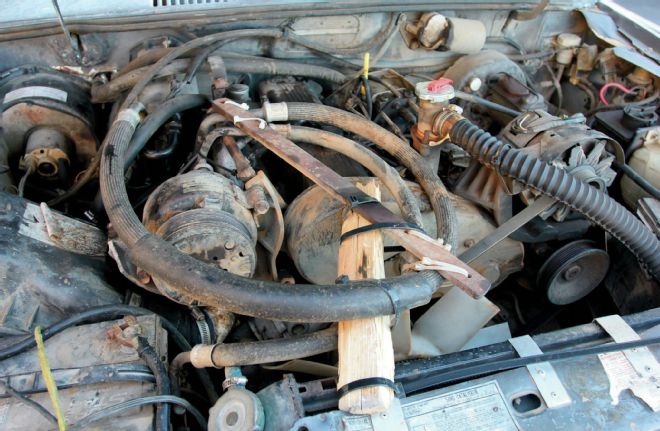
| 1985 Ford Ranger Engine Bay
This is what our engine bay looked like shortly after completing the 1,700-mile road trip. A coolant eruption had coated everything in a rust-colored film, we were missing a belt, and the metal rod and wood stake were a nice touch.
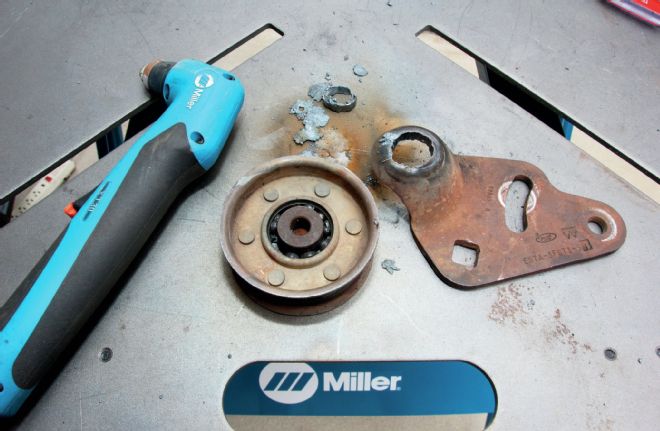
| 1985 Ford Ranger Idler Pulley.
To get things back in fighting shape again, the first order of business was repairing the seized idler pulley. However, since this is such a rare truck, no replacement part could be found. So, with the help of our handy plasma torch, we liberated the busted pulley from the factory tensioner bracket.
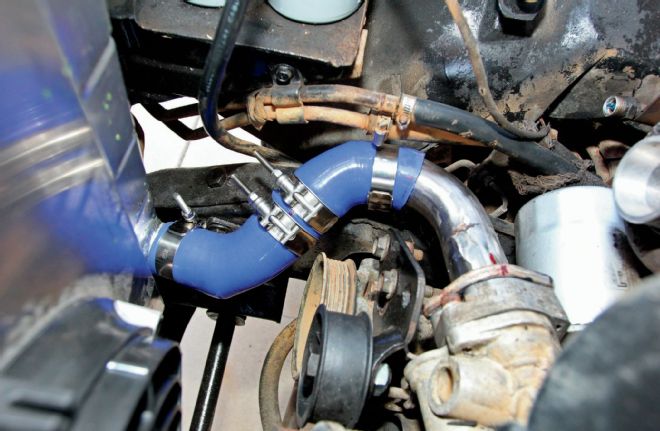
| 1985 Ford Ranger Tensioner Bracket
With the tensioner bracket repaired, we bolted on a new over-the-counter idler pulley and were ready to reinstall it on the truck. This fix returned the functionality of our power steering, which, as the only luxury the truck has, was much appreciated.
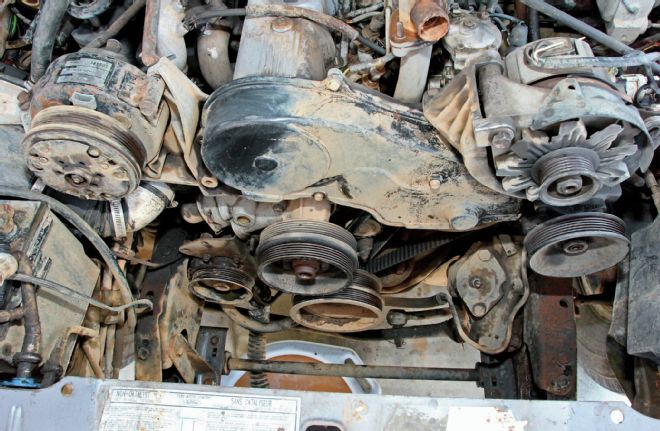
| 1985 Ford Ranger Cooling System
The Ford Ranger’s biggest issue was the cooling system. Bad repairs with incorrect parts had created a bottleneck so bad in the lower radiator hose that almost no fluid was circulating through the engine. This combined with the wrong radiator, a missing fan shroud, and bad temperature sensor created headaches on our cross-country trek. We started the repair by removing the old radiator and factory clutch fan.
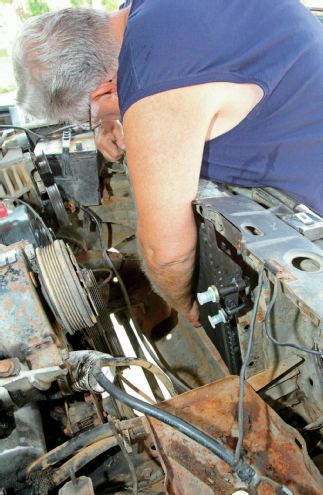
| 1985 Ford Ranger Factory Air Conditioning
George Mudrock, who you might remember aided and abetted us while we were in Kansas at the beginning of this adventure, happened to be in California for a few days and graciously spent one of them helping us work on the Ranger. Since the truck actually has factory air conditioning—albeit nonfunctioning—we decided to replace the condenser while the radiator was out with this new one from LMC Truck.
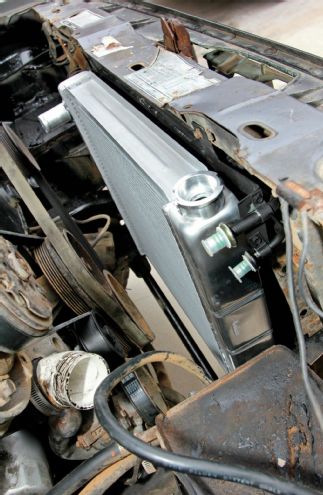
| 1985 Ford Ranger Radiator
Finding parts for the 29-year-old diesel mini proved about as difficult as locating the truck to begin with. Since we couldn’t locate a stock replacement radiator and wanted better cooling anyway, we called up Summit Racing and ordered one of its universal-fit aluminum radiators. This 2.25-inch-thick, two-row radiator fit perfectly and had the inlet and outlet exactly where we needed them to be.
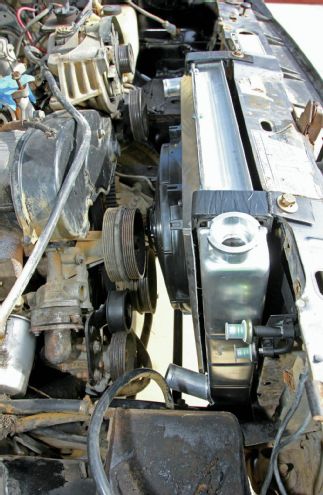
| 1985 Ford Ranger Summit Radiator
Fortunately for us, the radiator we ordered was available as a complete kit from Summit. It came with a 14-inch electric fan, fan shroud, all necessary wiring, and a set of universal mounting brackets. Since the radiator would provide more than adequate cooling, switching to an electric fan was an easy choice, as it would free up a few additional horsepower we so desperately needed.
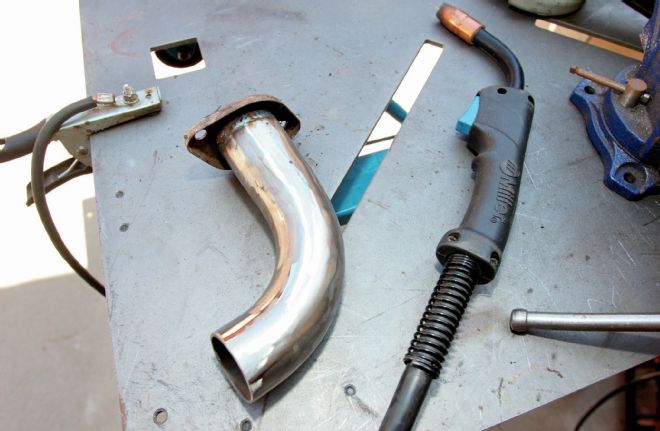
| 1985 Ford Ranger Coolant Inlet
To plumb the radiator in a more direct manner, we decided to completely rework the lower hose routing. Once again, the fabrication tools were brought out as we cut apart the factory coolant inlet and rebuilt it with stainless steel tubing.

| 1985 Ford Ranger Thermostat Housing
Here you can see the new lower coolant inlet tube attached to the thermostat housing on the engine. Previously, coolant had to pass behind the accessory drive, loop under, and then make a 90-degree turn into the radiator. This created a complex series of bends with many potential pinch points. The new routing takes coolant around the belts and directly into the engine.
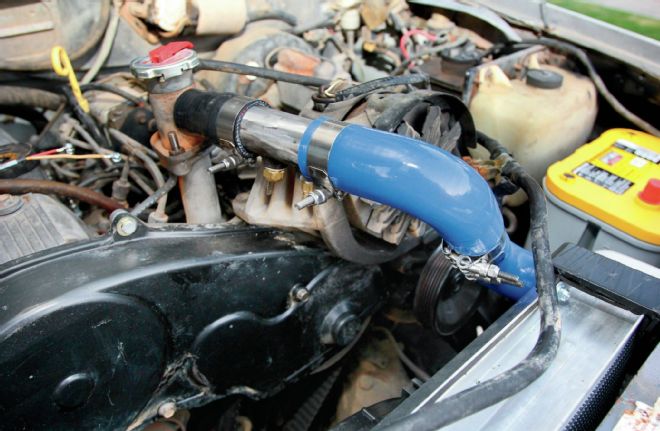
| 1985 Ford Ranger Upper Radiator Hose
We also chose to build a new upper radiator hose. We opted to use silicon hoses because we were able to order the proper bends, sizes, and reducers to complete the custom hose routing, as well as T-bolt clamps for reliability. Located in the upper hose are the temperature probes for the electric fan switch and Auto Meter gauge.
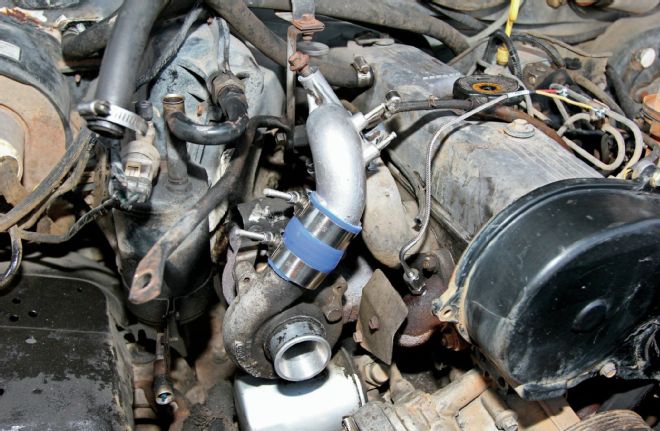
| 1985 Ford Ranger Replacing Hoses
To keep an eye on our exhaust gas temperature, we drilled and tapped the exhaust manifold and installed an Auto Meter pyrometer. While this location may not give us the absolute best reading possible, it was the easiest to get to without removing the manifold.
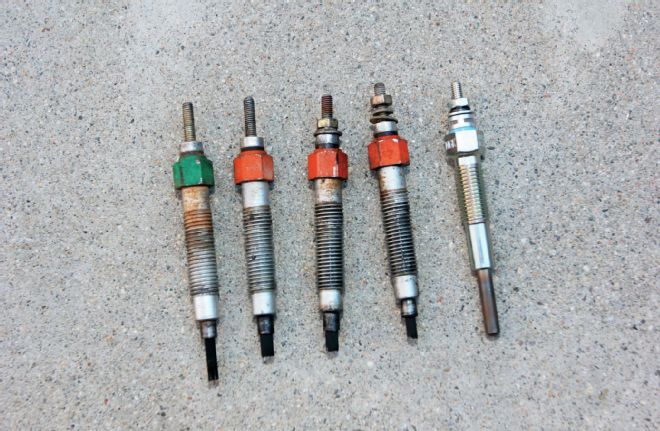
| 1985 Ford Ranger NGK Glow Plugs
Searching for reliability meant we needed to address the hard-starting issue that surfaced halfway through the trip home to California. A quick look at the glow plugs revealed the issue, as they were found to be missing most of their heating elements (left). We screwed in four new NGK glow plugs (right) and the truck now starts quickly every time.
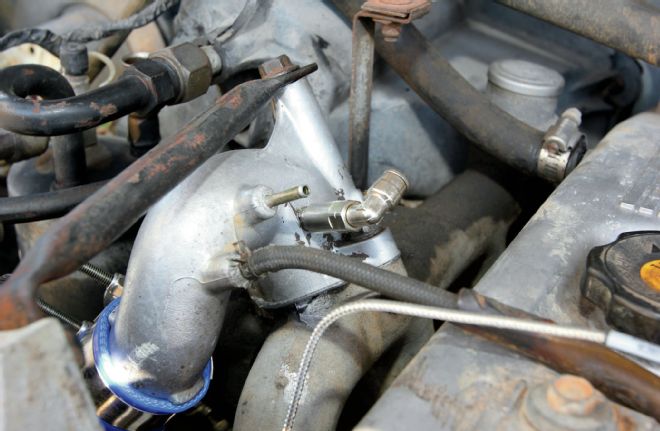
| 1985 Ford Ranger Snow Performance Water Methanol Injection Nozzle
The intake elbow provides ports for boost-referencing for the injection pump and wastegate, so this is where we decided to drill and tap for our Snow Performance water-methanol injection nozzle, and Auto Meter boost gauge port. We’ll cover the water-meth injection in a future issue.
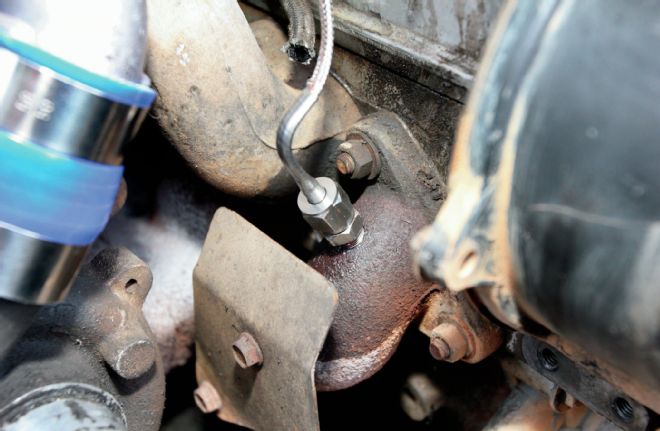
| 1985 Ford Ranger Auto Meter Pyrometer
While we were replacing hoses, we decided to change the turbo boot to silicon as well, replacing the cracking factory piece and loose clamps.
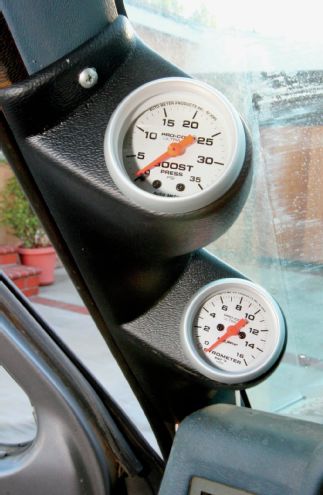
| 1985 Ford Ranger Pillar Pod
Speaking of gauges, we modified a late-model Ford Ranger pillar pod to fit our ’85 and hold a pair of Auto Meter boost and pyrometer gauges. Our 2.3L sees boost pressure top out at 11 psi (which is a bit low even for this truck) and a max EGT of about 1,200 degrees pulling up grades.
A pair of Optima YellowTop deep-cycle batteries replaced the old lead-acid units the truck came with. We also swapped out the worn bungee cords for proper battery hold-downs and replaced the necessary cables as well. These two batteries provide more than enough cranking power to get the high-compression IDI spinning.
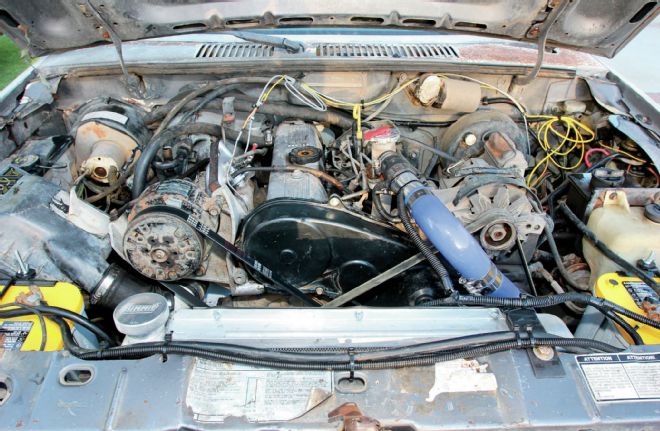
| 1985 Ford Ranger Engine
The little engine is starting to look good all cleaned up. We’ve got a few more issues to address before we really start cranking up the power, but we think we’re headed in the right direction.
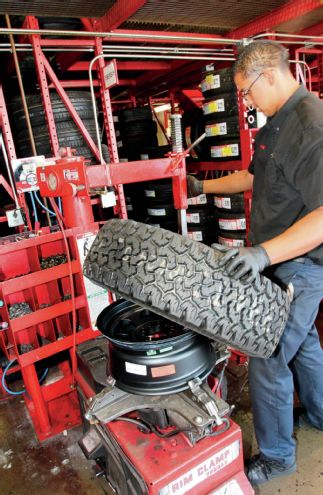
| 1985 Ford Ranger BFGoodrich All Terrain TA KO
Before we could trust the truck to commuting duties we needed to address the cracked and rotted tires it came with. Wanting to keep a similar look, we opted for a set of 31x10.5R15 BFGoodrich All-Terrain T/A KO tires and mounted them on 15x7-inch Mickey Thompson Classic III black wheels. The experts at America’s Tire in Artesia, California, got our tires and wheels mounted and balanced. Both the BFG tires and Mickey Thompson wheels were incredibly true, requiring very little weight to balance.
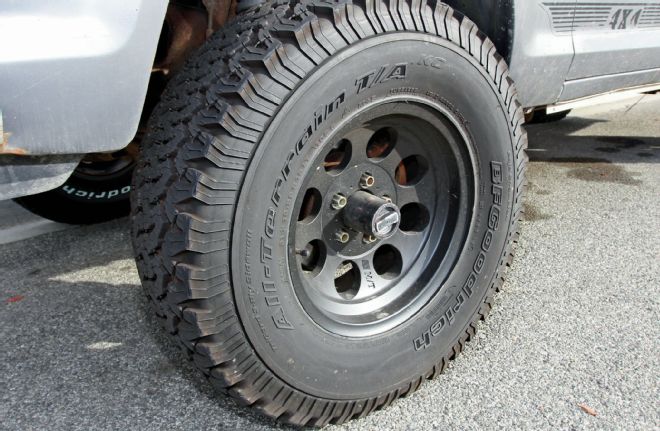
| 1985 Ford Ranger BFGoodrich All Terrain
 | 1985 Ford Ranger Engine Bay
This is what our engine bay looked like shortly after completing the 1,700-mile road trip. A coolant eruption had coated everything in a rust-colored film, we were missing a belt, and the metal rod and wood stake were a nice touch.
| 1985 Ford Ranger Engine Bay
This is what our engine bay looked like shortly after completing the 1,700-mile road trip. A coolant eruption had coated everything in a rust-colored film, we were missing a belt, and the metal rod and wood stake were a nice touch.
 | 1985 Ford Ranger Idler Pulley.
To get things back in fighting shape again, the first order of business was repairing the seized idler pulley. However, since this is such a rare truck, no replacement part could be found. So, with the help of our handy plasma torch, we liberated the busted pulley from the factory tensioner bracket.
| 1985 Ford Ranger Idler Pulley.
To get things back in fighting shape again, the first order of business was repairing the seized idler pulley. However, since this is such a rare truck, no replacement part could be found. So, with the help of our handy plasma torch, we liberated the busted pulley from the factory tensioner bracket.
 | 1985 Ford Ranger Tensioner Bracket
With the tensioner bracket repaired, we bolted on a new over-the-counter idler pulley and were ready to reinstall it on the truck. This fix returned the functionality of our power steering, which, as the only luxury the truck has, was much appreciated.
| 1985 Ford Ranger Tensioner Bracket
With the tensioner bracket repaired, we bolted on a new over-the-counter idler pulley and were ready to reinstall it on the truck. This fix returned the functionality of our power steering, which, as the only luxury the truck has, was much appreciated.
 | 1985 Ford Ranger Cooling System
The Ford Ranger’s biggest issue was the cooling system. Bad repairs with incorrect parts had created a bottleneck so bad in the lower radiator hose that almost no fluid was circulating through the engine. This combined with the wrong radiator, a missing fan shroud, and bad temperature sensor created headaches on our cross-country trek. We started the repair by removing the old radiator and factory clutch fan.
| 1985 Ford Ranger Cooling System
The Ford Ranger’s biggest issue was the cooling system. Bad repairs with incorrect parts had created a bottleneck so bad in the lower radiator hose that almost no fluid was circulating through the engine. This combined with the wrong radiator, a missing fan shroud, and bad temperature sensor created headaches on our cross-country trek. We started the repair by removing the old radiator and factory clutch fan.
 | 1985 Ford Ranger Factory Air Conditioning
George Mudrock, who you might remember aided and abetted us while we were in Kansas at the beginning of this adventure, happened to be in California for a few days and graciously spent one of them helping us work on the Ranger. Since the truck actually has factory air conditioning—albeit nonfunctioning—we decided to replace the condenser while the radiator was out with this new one from LMC Truck.
| 1985 Ford Ranger Factory Air Conditioning
George Mudrock, who you might remember aided and abetted us while we were in Kansas at the beginning of this adventure, happened to be in California for a few days and graciously spent one of them helping us work on the Ranger. Since the truck actually has factory air conditioning—albeit nonfunctioning—we decided to replace the condenser while the radiator was out with this new one from LMC Truck.
 | 1985 Ford Ranger Radiator
Finding parts for the 29-year-old diesel mini proved about as difficult as locating the truck to begin with. Since we couldn’t locate a stock replacement radiator and wanted better cooling anyway, we called up Summit Racing and ordered one of its universal-fit aluminum radiators. This 2.25-inch-thick, two-row radiator fit perfectly and had the inlet and outlet exactly where we needed them to be.
| 1985 Ford Ranger Radiator
Finding parts for the 29-year-old diesel mini proved about as difficult as locating the truck to begin with. Since we couldn’t locate a stock replacement radiator and wanted better cooling anyway, we called up Summit Racing and ordered one of its universal-fit aluminum radiators. This 2.25-inch-thick, two-row radiator fit perfectly and had the inlet and outlet exactly where we needed them to be.
 | 1985 Ford Ranger Summit Radiator
Fortunately for us, the radiator we ordered was available as a complete kit from Summit. It came with a 14-inch electric fan, fan shroud, all necessary wiring, and a set of universal mounting brackets. Since the radiator would provide more than adequate cooling, switching to an electric fan was an easy choice, as it would free up a few additional horsepower we so desperately needed.
| 1985 Ford Ranger Summit Radiator
Fortunately for us, the radiator we ordered was available as a complete kit from Summit. It came with a 14-inch electric fan, fan shroud, all necessary wiring, and a set of universal mounting brackets. Since the radiator would provide more than adequate cooling, switching to an electric fan was an easy choice, as it would free up a few additional horsepower we so desperately needed.
 | 1985 Ford Ranger Coolant Inlet
To plumb the radiator in a more direct manner, we decided to completely rework the lower hose routing. Once again, the fabrication tools were brought out as we cut apart the factory coolant inlet and rebuilt it with stainless steel tubing.
| 1985 Ford Ranger Coolant Inlet
To plumb the radiator in a more direct manner, we decided to completely rework the lower hose routing. Once again, the fabrication tools were brought out as we cut apart the factory coolant inlet and rebuilt it with stainless steel tubing.
 | 1985 Ford Ranger Thermostat Housing
Here you can see the new lower coolant inlet tube attached to the thermostat housing on the engine. Previously, coolant had to pass behind the accessory drive, loop under, and then make a 90-degree turn into the radiator. This created a complex series of bends with many potential pinch points. The new routing takes coolant around the belts and directly into the engine.
| 1985 Ford Ranger Thermostat Housing
Here you can see the new lower coolant inlet tube attached to the thermostat housing on the engine. Previously, coolant had to pass behind the accessory drive, loop under, and then make a 90-degree turn into the radiator. This created a complex series of bends with many potential pinch points. The new routing takes coolant around the belts and directly into the engine.
 | 1985 Ford Ranger Upper Radiator Hose
We also chose to build a new upper radiator hose. We opted to use silicon hoses because we were able to order the proper bends, sizes, and reducers to complete the custom hose routing, as well as T-bolt clamps for reliability. Located in the upper hose are the temperature probes for the electric fan switch and Auto Meter gauge.
| 1985 Ford Ranger Upper Radiator Hose
We also chose to build a new upper radiator hose. We opted to use silicon hoses because we were able to order the proper bends, sizes, and reducers to complete the custom hose routing, as well as T-bolt clamps for reliability. Located in the upper hose are the temperature probes for the electric fan switch and Auto Meter gauge.
 | 1985 Ford Ranger Replacing Hoses
To keep an eye on our exhaust gas temperature, we drilled and tapped the exhaust manifold and installed an Auto Meter pyrometer. While this location may not give us the absolute best reading possible, it was the easiest to get to without removing the manifold.
| 1985 Ford Ranger Replacing Hoses
To keep an eye on our exhaust gas temperature, we drilled and tapped the exhaust manifold and installed an Auto Meter pyrometer. While this location may not give us the absolute best reading possible, it was the easiest to get to without removing the manifold.
 | 1985 Ford Ranger NGK Glow Plugs
Searching for reliability meant we needed to address the hard-starting issue that surfaced halfway through the trip home to California. A quick look at the glow plugs revealed the issue, as they were found to be missing most of their heating elements (left). We screwed in four new NGK glow plugs (right) and the truck now starts quickly every time.
| 1985 Ford Ranger NGK Glow Plugs
Searching for reliability meant we needed to address the hard-starting issue that surfaced halfway through the trip home to California. A quick look at the glow plugs revealed the issue, as they were found to be missing most of their heating elements (left). We screwed in four new NGK glow plugs (right) and the truck now starts quickly every time.
 | 1985 Ford Ranger Snow Performance Water Methanol Injection Nozzle
The intake elbow provides ports for boost-referencing for the injection pump and wastegate, so this is where we decided to drill and tap for our Snow Performance water-methanol injection nozzle, and Auto Meter boost gauge port. We’ll cover the water-meth injection in a future issue.
| 1985 Ford Ranger Snow Performance Water Methanol Injection Nozzle
The intake elbow provides ports for boost-referencing for the injection pump and wastegate, so this is where we decided to drill and tap for our Snow Performance water-methanol injection nozzle, and Auto Meter boost gauge port. We’ll cover the water-meth injection in a future issue.
 | 1985 Ford Ranger Auto Meter Pyrometer
While we were replacing hoses, we decided to change the turbo boot to silicon as well, replacing the cracking factory piece and loose clamps.
| 1985 Ford Ranger Auto Meter Pyrometer
While we were replacing hoses, we decided to change the turbo boot to silicon as well, replacing the cracking factory piece and loose clamps.
 | 1985 Ford Ranger Pillar Pod
Speaking of gauges, we modified a late-model Ford Ranger pillar pod to fit our ’85 and hold a pair of Auto Meter boost and pyrometer gauges. Our 2.3L sees boost pressure top out at 11 psi (which is a bit low even for this truck) and a max EGT of about 1,200 degrees pulling up grades.
| 1985 Ford Ranger Pillar Pod
Speaking of gauges, we modified a late-model Ford Ranger pillar pod to fit our ’85 and hold a pair of Auto Meter boost and pyrometer gauges. Our 2.3L sees boost pressure top out at 11 psi (which is a bit low even for this truck) and a max EGT of about 1,200 degrees pulling up grades.
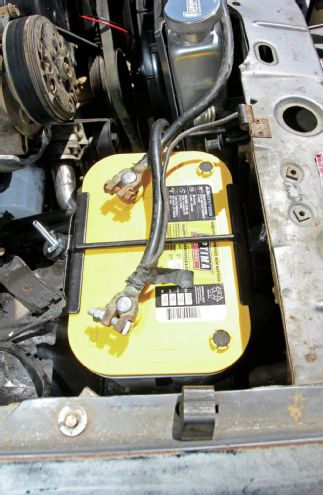
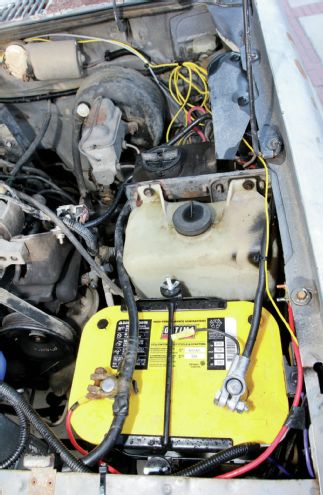
 | 1985 Ford Ranger Engine
The little engine is starting to look good all cleaned up. We’ve got a few more issues to address before we really start cranking up the power, but we think we’re headed in the right direction.
| 1985 Ford Ranger Engine
The little engine is starting to look good all cleaned up. We’ve got a few more issues to address before we really start cranking up the power, but we think we’re headed in the right direction.
 | 1985 Ford Ranger BFGoodrich All Terrain TA KO
Before we could trust the truck to commuting duties we needed to address the cracked and rotted tires it came with. Wanting to keep a similar look, we opted for a set of 31x10.5R15 BFGoodrich All-Terrain T/A KO tires and mounted them on 15x7-inch Mickey Thompson Classic III black wheels. The experts at America’s Tire in Artesia, California, got our tires and wheels mounted and balanced. Both the BFG tires and Mickey Thompson wheels were incredibly true, requiring very little weight to balance.
| 1985 Ford Ranger BFGoodrich All Terrain TA KO
Before we could trust the truck to commuting duties we needed to address the cracked and rotted tires it came with. Wanting to keep a similar look, we opted for a set of 31x10.5R15 BFGoodrich All-Terrain T/A KO tires and mounted them on 15x7-inch Mickey Thompson Classic III black wheels. The experts at America’s Tire in Artesia, California, got our tires and wheels mounted and balanced. Both the BFG tires and Mickey Thompson wheels were incredibly true, requiring very little weight to balance.
 | 1985 Ford Ranger BFGoodrich All Terrain
| 1985 Ford Ranger BFGoodrich All Terrain